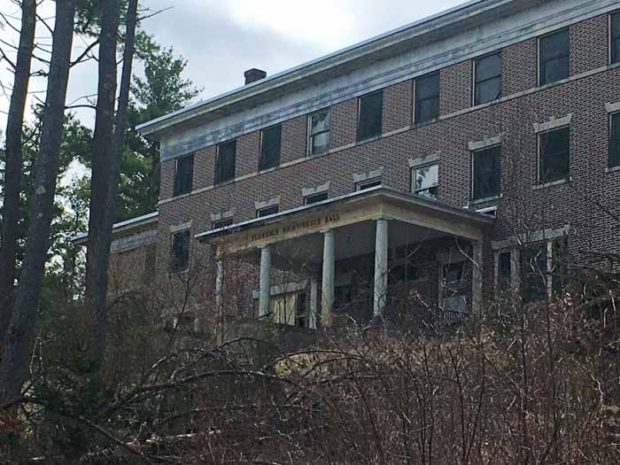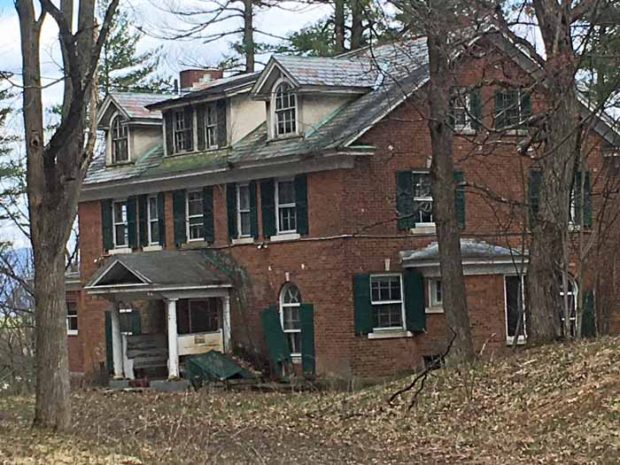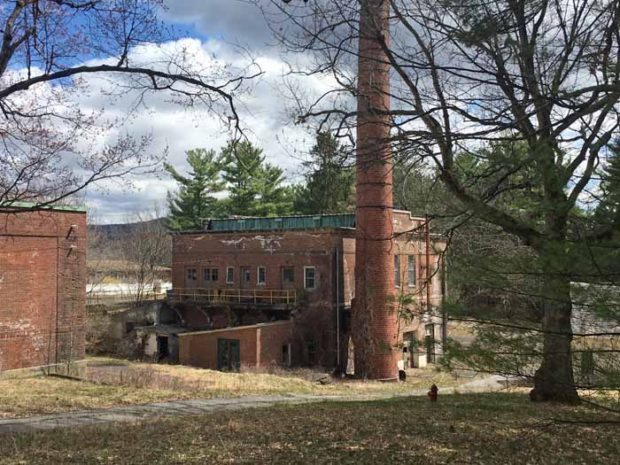The ruins of Mary McClellan Hospital stand on a hill overlooking the village of Cambridge, New York, in what was a “flyover” corner of the country until the planes stopped flying. The hospital cornerstone was laid July 4, 1917. The USA had entered the war against Germany a few months earlier. The “Spanish” flu pandemic kicked off in January 1918. The hospital opened in January 1919. The flu burned out a year later. The hospital shut down for good in 2003.
I’ve lived around here for decades and never actually got a look at the place until I went up there on a blustery spring Saturday before Easter to look around. I like to read landscapes and the human imprint upon them. This one is a ghost story, not just of the bygone souls who came and went here, but of an entire society, the nation that we used to be and stopped being not so long ago.
This is the old main building today. It’s astounding how quickly buildings begin to rot when the human life within them is gone. The style was Beaux Arts Institutional, seen everywhere across America in that period in schools, libraries, museums, and hospitals, an austere neoclassicism that radiated decorum in a confident and well-run society – because that is what we were then. Note especially, the entrance and the beautiful bronze marquee above it. The message is this: You enter through a portal of beauty to a place of hope and trust.
This is Mary McClellan Hospital not long after it opened. The site itself, on its hill, with views east across the state line to the Green Mountains, speaks of authority and command. The America of 1919 was a deeply hierarchical society. Today we regard hierarchy as a bane and a curse. The truth is, it is absolutely required if you expect to live in a well-run society, and proof of that is the disordered mess of bureaucratic irresponsibility we live in today, with virtually every institution failing – well before the Covid-19 virus arrived on the scene — and nobody called to account for anything anymore. Hierarchy must be fit to scale to function successfully. In small institutions like this, everybody knows who is responsible for what. That’s what makes authority credible.
These are the ruins of the nursing school associated with the hospital (and also associated with Skidmore College in Saratoga Springs, 25 miles west). The nurses lived here, in Florence Nightingale Hall. In the early 20th century, the profession favored young, unmarried women whose allegiance and attention to the patients would not be distracted by the needs of a family. Was that exploitation? Or was it simply an intelligent way to organize a hospital subculture? The nurses lived here very comfortably. The institution cared for them, literally.
There’s no record available of what exactly these buildings were for. The one in the foreground has a cut stone sign that says “The Junior” on it. I infer that this may have been where a couple of staff resident physicians lived, young men probably, just out of their internships, close at hand and on-call for emergencies. The building in the background is a rather grand country cottage, possibly the residence of the chief surgeon or the hospital director. The hospital was, after all, a community unto itself, and it was important that authority have a visible presence there all the time. Both buildings display architectural grace-notes that humanized and dignified that resident authority. We no longer believe in grace-notes for the things we build, so is it surprising that we live in a graceless society?
This is the power plant for the whole operation, on the premises, ensuring that the electricity would stay on at all times. In the early 20th century, electric power was the new sine qua non of advanced civilization. America’s rural electrification program really didn’t get underway until the 1930s, so it’s likely that many of the farms outside the village were not hooked up to a grid. The hospital generators must have been driven by coal, or perhaps oil. Somebody had to attend to all that machinery. The laundry – hospitals produce a lot of that – was also on-premises, as was all the meal preparation. The hospital maintained a large garden to furnish some of the food. All these tasks required crews of people working purposefully and getting paid. The hospital was a complex organism, a world within a nation within a world.
Things rise and self-organize beautifully into fully-formed systems and after a while they run down, even while they over-grow; authority starts working more and more for its own sake and its own benefit; hierarchy breaks down into disrespect, lack of trust, fear; and then society loses its vital institutions, which is exactly what happened at Mary McClellan Hospital in little Cambridge, New York. It dwindled and then quickly collapsed. The town lost a part of itself, the part that welcomed people in a particular kind of trouble and cared for them, as it cared for those who did the caring. By the way, in 1919, a private room was $7-a-day (a bed on a ward was $3). Imagine that! The town also lost a vital component of its economy. And that was all of-a-piece with its decline into the flyover place it became in our time.
 Hoodwinked: How Intell...
Best Price: $8.84
Buy New $10.83
(as of 08:25 UTC - Details)
Hoodwinked: How Intell...
Best Price: $8.84
Buy New $10.83
(as of 08:25 UTC - Details)
American health care, as we call it today, and for all its high-tech miracles, has evolved into one of the most atrocious rackets the world has ever seen. By racket, I mean an enterprise organized explicitly to make money dishonestly. This is what we’ve become, and the fact that we seem to be okay with that tells you more about what we have become. The advent of Covid-19, along with the extreme economic disorders it has triggered, will probably be the beginning of the end of that racket. We have no idea how medicine will re-organize itself, but I’d guess that it will happen at a much more primitive scale – because that’s usually what happens when human societies overshoot badly. Alas, history is not exactly symmetrical.
But read these photos and meditate on what we were once capable of putting together in this land, and maybe you will find some clues about what was truly admirable about the American condition before we stopped caring.
Reprinted with permission from Kunstler.com.
 The Devil’s Ches...
Best Price: $3.67
Buy New $41.00
(as of 10:40 UTC - Details)
The Devil’s Ches...
Best Price: $3.67
Buy New $41.00
(as of 10:40 UTC - Details)
 The Phoenix Program
Best Price: $14.55
Buy New $11.00
(as of 04:30 UTC - Details)
The Phoenix Program
Best Price: $14.55
Buy New $11.00
(as of 04:30 UTC - Details)
 The New World Order
Best Price: $9.31
Buy New $14.00
(as of 03:26 UTC - Details)
The New World Order
Best Price: $9.31
Buy New $14.00
(as of 03:26 UTC - Details)













